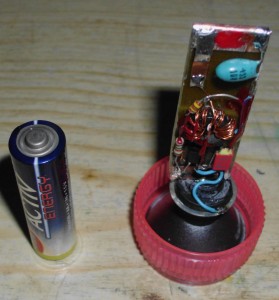 Peter is experimenting with my Supercharged Joule thief circuit. His picture is one of his recent results: a Supercharged Joule Thief flashlight. I quote:
Peter is experimenting with my Supercharged Joule thief circuit. His picture is one of his recent results: a Supercharged Joule Thief flashlight. I quote:
Hello and thanks for the fast answer,
Now I want an SJT as a nightlight cause there are many so called “depleted” batteries lying around – I built one on breadboard with a blue LED but it was too bright!
Is there a possibility to regulate or decrease the brightness?Of course I give you permission to use this in your blog! At the moment I´m using two old AA cells in parallel which should give me enough energy for a decent time.
I understand the tweak with the resistor but have a question on the capacitor: “Should I measure the current the circuit consumes and choose the one which makes it consume the least?” Is this what you meant?Thanks
Peter
Peter:
Increase the 1.5k resistor to 3.3k, 4.7k, or higher, until you have the desired LED brightness. This may change the optimum point, so the 680pF or whatever capacitor may not be the best choice. The peak of the optimum point is very broad, so adjusting the 680pF may not have a large effect. But I think that it is always a good idea to tune the SJT to save battery current. And that is especially important when you are using button cells. Thanks for the pictures. I haven’t had time to work on my blog, but when I do, I’ll try to update it with your pictures
I put a 1 ohm resistor in series with the LED cathode. I measure the millivolts across it, and each millivolt is equal to 1 milliamp. Then as the capacitor is changed, the LED current will have a broad peak. I put ten 100 pF disk capacitors in parallel on a PC board with each capacitor connected to one of the switches on a 10 position DIP switch. I can then switch on the capacitors so they add up to 1000 pF. For the 1.5k, I’ve found that the capacitor is typically between 560 pF and 1000 pF, depending on the coil and current. Typically the core I use is the Fair-Rite 2673002402 with ten to 12 turns of 24 AWG (0.5mm) wound bifilar. The inductance of each winding is typically above 200 microhenrys. The Supercharged Joule Thief circuit runs at 3 or 4 times the frequency of a typical conventional JT – maybe 200 to 250 kHz.
More experimenting? Probably.